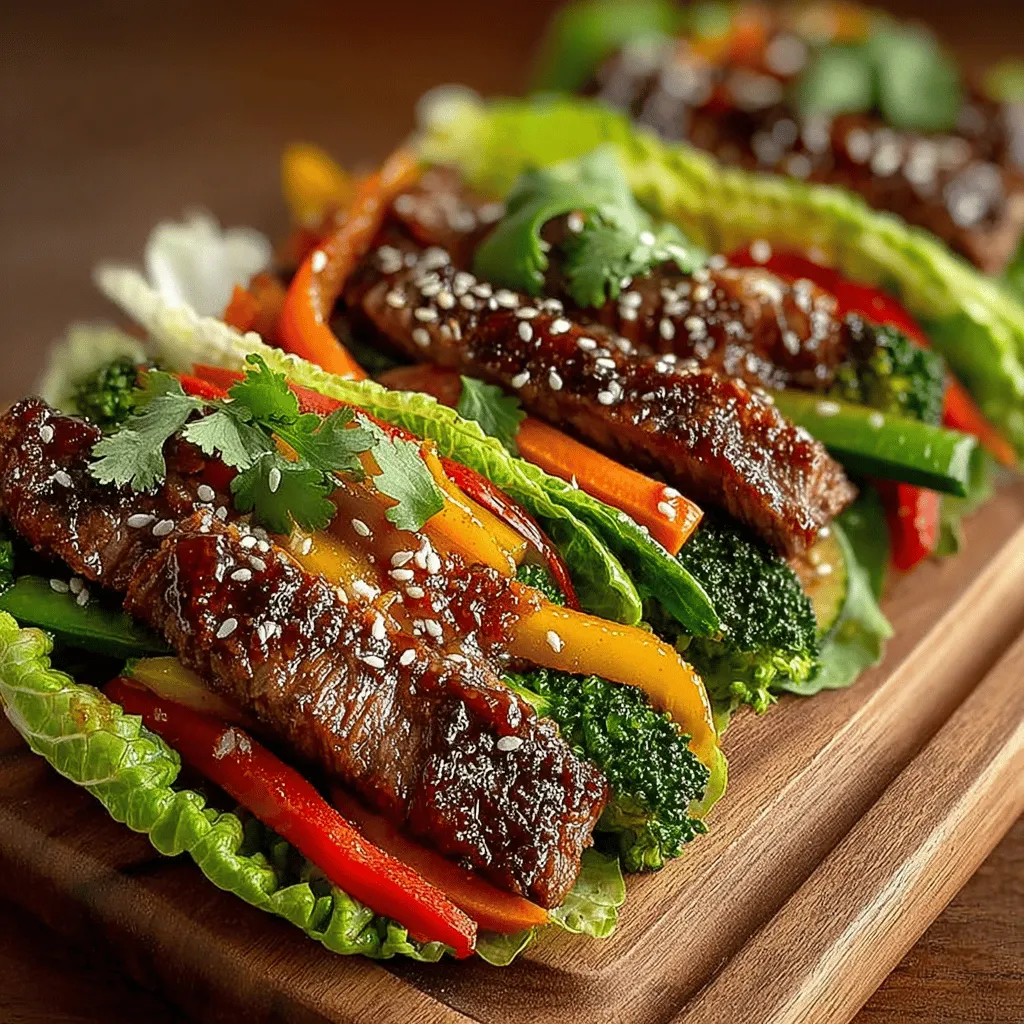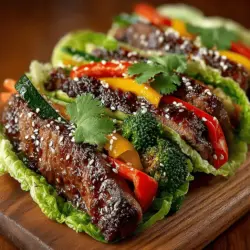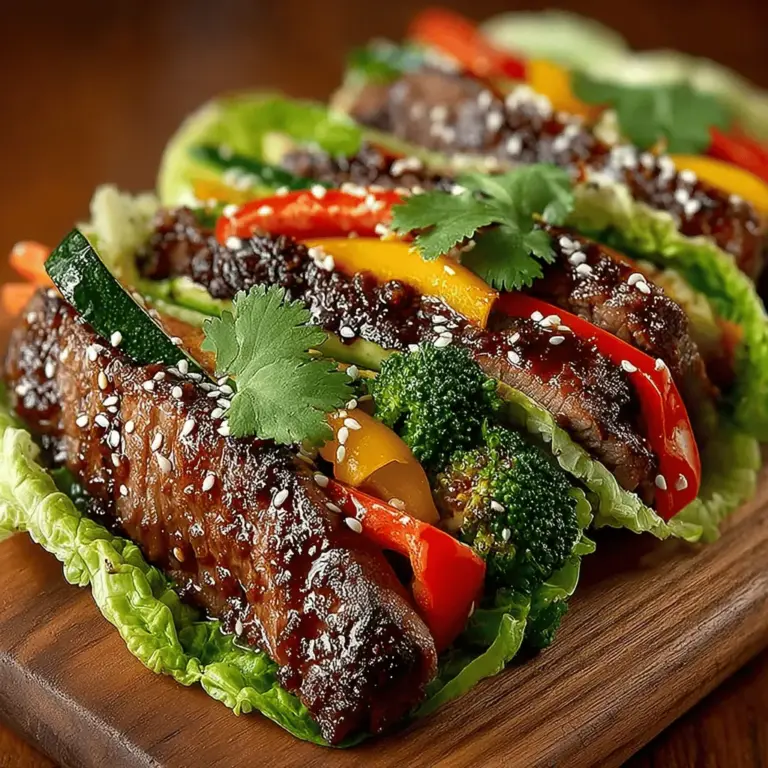Introduction
In the quest for quick and nutritious meals, savory beef and vegetable stir-fry wraps emerge as a delicious solution. This recipe combines tender flank steak with vibrant vegetables, all nestled in crisp lettuce leaves for a satisfying and healthy dish. Ideal for busy weeknights or meal prep, these wraps are not only easy to make but also packed with flavor and nutrients. Join us as we explore the ins and outs of this delightful recipe, perfect for family dinners or gatherings with friends.
Ingredients
– 1 lb flank steak, thinly sliced against the grain
– 2 tablespoons soy sauce
– 1 tablespoon oyster sauce
– 1 tablespoon cornstarch
– 1 tablespoon vegetable oil
– 1 bell pepper, sliced (any color)
– 1 zucchini, sliced
– 1 cup broccoli florets
– 1 carrot, julienned
– 1 tablespoon minced garlic
– 1 tablespoon minced ginger
– Salt and pepper to taste
– 1 head of butter or romaine lettuce, leaves separated for wrapping
Instructions
1. In a mixing bowl, combine the sliced flank steak, soy sauce, oyster sauce, and cornstarch. Mix well to coat the beef evenly and let it marinate for at least 30 minutes.
2. While the beef is marinating, wash and prepare the vegetables. Slice the bell pepper, zucchini, and carrot, and cut the broccoli into small florets.
3. Heat the vegetable oil in a large skillet or wok over high heat. Add the marinated beef and stir-fry for 3-4 minutes until browned and cooked through. Remove the beef from the skillet and set aside.
4. In the same skillet, add the minced garlic and ginger, sauté for about 30 seconds until fragrant.
5. Add the sliced bell pepper, zucchini, broccoli, and carrot to the skillet. Stir-fry for 3-5 minutes or until the vegetables are tender-crisp.
6. Return the cooked beef to the skillet with the vegetables and toss everything together. Season with salt and pepper to taste.
7. Remove from heat and let the mixture cool slightly before assembling the wraps.
Understanding the Ingredients
Exploring the Core Components
– Flank Steak: A versatile cut known for its flavor and tenderness. It absorbs marinades well and cooks quickly, making it perfect for stir-frying.
– Soy Sauce and Oyster Sauce: These sauces are essential for creating that umami flavor that enhances the overall taste of the dish.
– Fresh Vegetables: Incorporating bell peppers, zucchini, broccoli, and carrots not only adds color but also boosts the nutritional value of your wraps.
Marinating the Beef
The Importance of Marination
Marinating the beef is crucial for enhancing both flavor and tenderness. The combination of soy sauce, oyster sauce, and cornstarch creates a flavorful coating that helps to lock in moisture during cooking. For optimal results, marinate the beef for at least 30 minutes, but longer if time allows.
Preparing the Vegetables
Choosing the Right Vegetables for Stir-Fry
Using fresh produce is essential for achieving the best texture and flavor in your stir-fry. You can also substitute vegetables based on availability or personal preference; for example, snap peas, mushrooms, or bok choy can be excellent alternatives. When prepping vegetables, aim for uniform sizes to ensure they cook evenly.
Cooking Techniques for Stir-Fry
Mastering the Art of Stir-Frying
Stir-frying requires high heat and quick cooking to retain the crunch of vegetables and the juiciness of meat. Use a well-seasoned cast-iron skillet or a non-stick wok for the best results. Start by cooking the beef separately to achieve the perfect sear, then follow with the vegetables to maintain their vibrant colors and textures.
Combining the Ingredients
Bringing It All Together
Once the beef and vegetables are cooked, combine them in the skillet, allowing the flavors to meld together for a few minutes before serving. The final step is to scoop the savory mixture into crisp lettuce leaves, creating a delightful wrap that is as enjoyable to eat as it is to prepare.

Timing: When to Add Ingredients for the Best Flavor
To achieve the most flavorful savory beef and vegetable stir-fry wraps, timing is crucial. Start by marinating the beef in your chosen sauce for at least 30 minutes to allow it to absorb the flavors. Once you begin cooking, add the beef to a hot pan first, as it requires more time to cook through.
Once the beef is nearly done, introduce firmer vegetables like bell peppers and carrots, which take longer to soften. Finally, add quicker-cooking vegetables such as mushrooms and spinach just a minute or two before removing the stir-fry from heat. This staggered approach ensures each ingredient retains its texture and flavor, resulting in a harmonious blend in your wraps.
Seasoning Tips: Balancing Flavors with Salt and Pepper
Seasoning is essential for enhancing the overall taste of your stir-fry. Start with a base of salt and pepper; however, be cautious not to overpower the natural flavors of the beef and vegetables. Use kosher salt for its coarse texture, which helps to evenly distribute throughout the dish.
For additional depth, consider incorporating soy sauce or tamari for umami flavor, and finish with a dash of sesame oil for a rich, nutty aroma. Taste and adjust seasonings gradually, ensuring a balanced profile that enhances the ingredients rather than masking them.
Visual Cues to Know When the Dish is Ready
Knowing when your stir-fry is ready can be determined by visual cues. The beef should be browned and no longer pink in the center, while the vegetables should be vibrant in color and slightly tender yet still crisp. Avoid overcooking, as this can lead to a mushy texture. A quick toss in the pan should result in a glossy finish from the sauce, indicating that it has coated the ingredients evenly.
Creating the Perfect Wrap
Choosing the Right Lettuce: Romaine vs Butter Lettuce
When selecting lettuce for your wraps, consider the texture and sturdiness. Romaine lettuce offers a crunchy texture and is slightly sturdier, making it ideal for holding hearty fillings. On the other hand, butter lettuce provides a delicate, soft wrap that can easily fold around the ingredients, offering a tender bite. Choose based on your preference for texture and how much filling you plan to include.
Tips for Filling and Wrapping Without Spills
To prevent spills while assembling your wraps, avoid overfilling. Use a generous but manageable amount of filling, usually about two to three tablespoons, depending on the size of your lettuce leaf. Start by placing the filling in the center of the leaf, then fold the sides in and roll from the bottom up, tucking in the filling as you go. A toothpick can help secure the wrap if necessary, particularly if you are serving these at a gathering.
Serving Suggestions: Garnishing with Sesame Seeds and Cilantro
Enhance the presentation and flavor of your wraps by garnishing them with toasted sesame seeds and fresh cilantro. The sesame seeds add a delightful crunch and nutty flavor, while the cilantro provides a fresh, herbaceous contrast. Serve the wraps on a platter, allowing each guest to take their own, or as a fun DIY assembly station where everyone can customize their wraps.
Nutritional Benefits of Savory Beef and Vegetable Stir-Fry Wraps
A Healthy Meal Choice
Savory beef and vegetable stir-fry wraps are not only delicious but also nutritious. The protein content in beef supports muscle health and satiety, making it an excellent choice for a balanced meal.
The colorful vegetables not only add vitamins and minerals but also phytonutrients, which are beneficial for overall health. Opting for lettuce wraps instead of traditional tortillas significantly reduces carbohydrate intake, making this dish a great option for those following low-carb diets.
Serving Suggestions
Complementary Side Dishes to Enhance the Meal
To create a complete meal, consider pairing your wraps with light side dishes. A refreshing cucumber salad or a simple miso soup can complement the flavors of the stir-fry without overshadowing them. For added crunch, serve a side of pickled vegetables.
Beverage Pairings That Match the Savory Flavors
When it comes to beverages, light and refreshing options work best. Sparkling water with a splash of lime complements the dish beautifully, or you might opt for a crisp white wine such as Sauvignon Blanc that pairs well with the savory flavors of the beef and vegetables.
Presentation Tips for Making the Dish Visually Appealing
Presentation can elevate your dining experience. Arrange the wraps on a large platter, and garnish with additional herbs or a drizzle of sauce. Consider using colorful plates or bowls to contrast with the vibrant colors of the wraps. A sprinkle of sesame seeds on top can also add visual interest.
Storing Leftovers
Best Practices for Storing Cooked Stir-Fry Wraps
If you have leftovers, store them in an airtight container in the refrigerator. The wraps can be kept for up to three days; however, it’s best to store the filling separately from the lettuce to maintain freshness and crunch.
Reheating Tips to Preserve Texture and Flavor
When reheating, avoid using the microwave if possible, as it can make the wraps soggy. Instead, reheat the filling in a skillet over medium heat until warmed through. If you enjoy warm wraps, use fresh lettuce leaves to assemble them again after reheating.
Suggested Uses for Leftovers to Prevent Waste
Get creative with leftover stir-fry filling. It can be used as a topping for rice bowls, incorporated into an omelet, or mixed into a salad for added flavor and protein. This versatility helps minimize waste and keeps meals exciting.
Conclusion
Savory beef and vegetable stir-fry wraps are a culinary delight that brings together flavor, nutrition, and convenience. By mastering the marination and cooking techniques outlined in this recipe, you can create a dish that not only satisfies the palate but also supports a healthy lifestyle. Whether served as a quick weeknight dinner or an impressive dish for entertaining, these wraps are sure to become a staple in your home cooking repertoire. Enjoy the vibrant tastes and textures, and embrace the joy of preparing this delicious meal!


